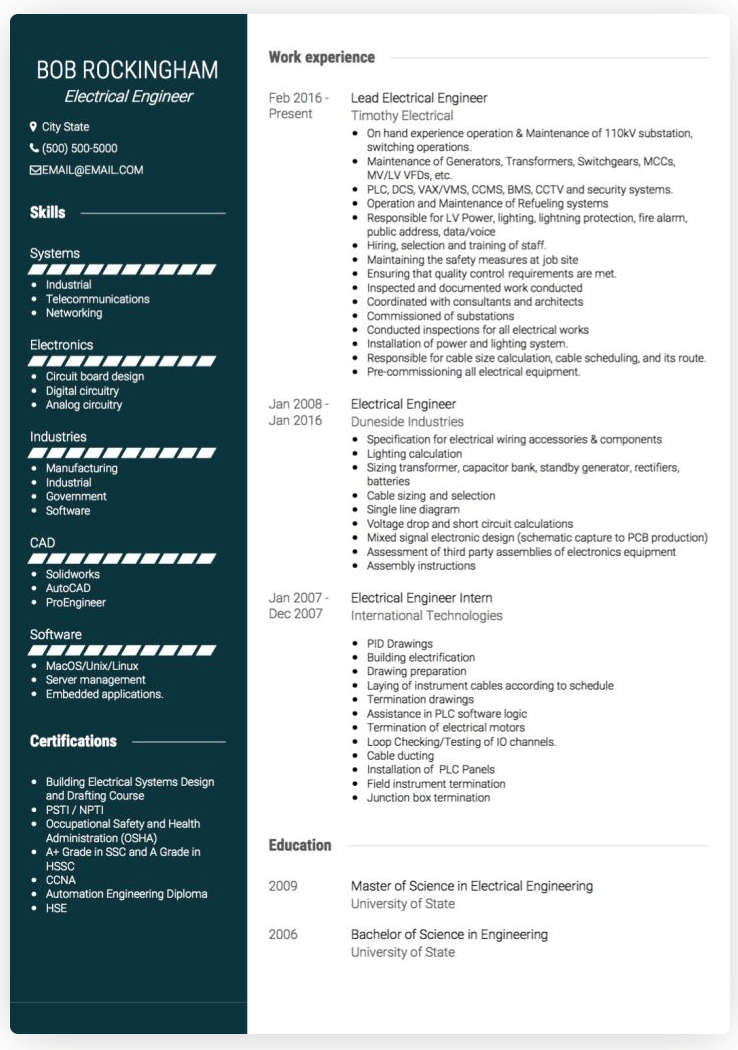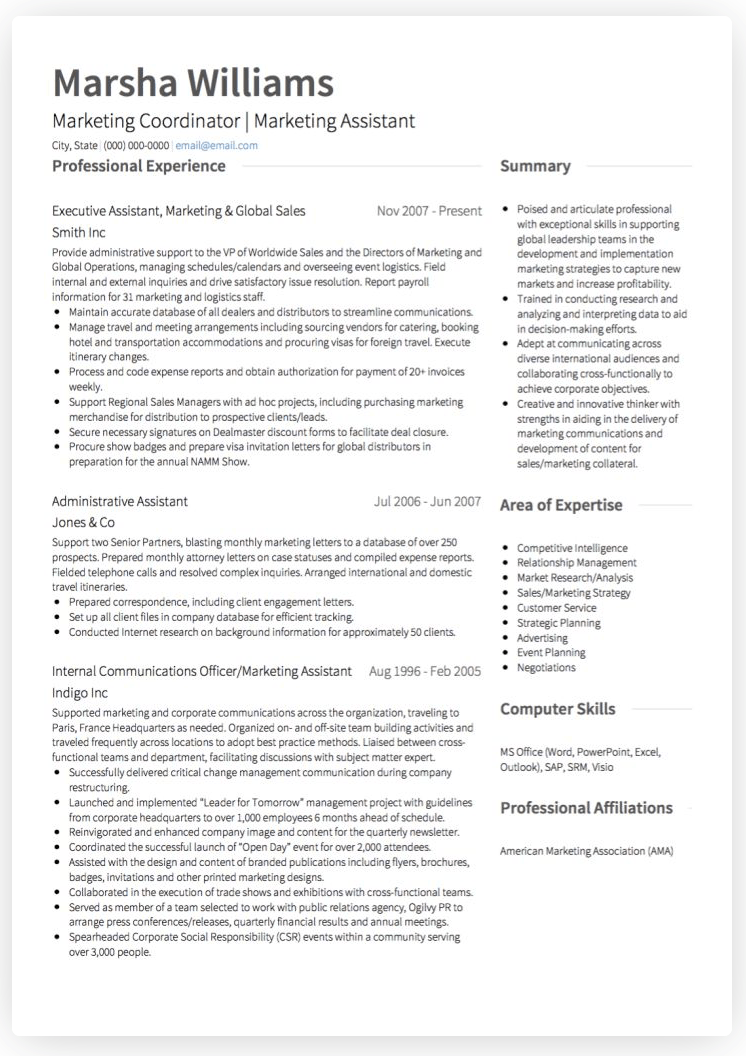
How to Write a Perfect Resume in 2021 | A Complete Guide

Having the knowledge to write a resume is one of the most important career skills you could have in 2021.
But most people don’t know how to do it.
Most people think of a resume as a document that lists their “experiences” and summarizes their skills. That’s why recruiters toss them after reviewing them for an average of six seconds.
Recommended links:
- Our collection of 500+ professional resume examples.
- Our gallery of 20+ downloadable resume templates.
Researchers conducted a scientific “eye tracking” study that analyzed how long various professional recruiters reviewed candidate profiles and resumes, and what those recruiters focused on. They found that recruiters look for how long candidates stay at jobs, whether or not they hit minimum education requirements, and how they’re progressing in their career, and more.
And the “decision” is made in a matter of seconds.
If you’re in the job market, it’s extremely important to make those seconds count. Otherwise, you’ll lose the hiring manager’s attention and you won’t hear from them again.
Especially because employers receive up to 250 applications per job, on average.
At the core of it, your resume is an advertisement. Its purpose is to “sell” you to the company you’re trying to work for. When you’re writing your resume your goal should be to get hiring managers to buy into what you’re selling, which would ultimately result in an interview.
In this guide, we’ll talk about how to craft a standout resume that gets the attention of hiring managers:
1. Focus on Storytelling: The Key to a Standout Resume
The best way to sell is through a story.
If you’re able to create a narrative in your resume similar to a fascinating, memorable story, you’ll command the attention of virtually any recruiter or hiring manager looking at your resume.
And most importantly -- it’ll set you apart from the hundreds of other candidates who think that a resume is just a place to talk about their skills and experience.
If you craft a story around your career path in your own, authentic style, you’ll paint a much more vivid picture of yourself through your resume, and entice recruiters and hiring managers to reach out to you to learn more.
Here are some tips on weaving a resume into a story:
Keep your target audience in mind
When you’re selling a product, you have to have a clear picture of who you’re selling to. If you try to sell something to everyone, you’ll end up with no customers.
Same thing applies to the job search process.
When you’re looking for a job, you shouldn’t try to appeal to every single employer. Most candidates are afraid of “closing too many doors” “pigeonholing” themselves.
But the truth is, the more you narrow your focus and get clear on what type of employers you’re trying to target, the more you’ll attract the kind of jobs you want and repel the ones you don’t.
This “targeting” goes deeper than just figuring out who you want to work for. You need to get clear on the type of job, the industries you want to work in, the level of job you want to go after, style of company culture, other factors that you might value.
From there, put yourself in the shoes of a hiring manager at that type of company.
What kind of concerns would they have about hiring someone? What would they be looking for? What red flags would they look for?
If you’re not sure, you can always talk to someone at the types of companies you might want to work for and do informational interviews.
Weave in “story elements” into your resume
Here are some story elements you could weave into your resume:
Characters: You’re the “main character” in your story. Other characters could be previous managers, colleagues you worked with, etc.
Setting: Your story’s setting could be companies you worked with or departments you worked in.
Plot: The plot of any good story follows some kind of narrative “arc.” Usually, these arcs take one of four patterns:
1. David vs Goliath:
In this type of story, you’re the “little guy” with the odds stacked against you (whether they’re time constraints, resource constraints, lack of buy-in, etc) but you still went on to achieve great things.
2. Rags to Riches:
Stories like this have the character starting off at the “bottom” and then ascending to the top. This might be the case if you landed some promotions at your last job, or accomplished something that’s supposed to be outside (or above) your role.
3. Transformation:
People also love stories of transformation. This might be your go-to narrative if you dealt with problems at your previous job that you faced - like managing an underperforming employee or customer conflicts.
Describe the challenge
Accomplishments are great to include on your resume, but they hold little meaning without context.
To provide that context, make sure you create a description around your challenges and what obstacles you faced before your success.
For example:
-
A challenge related to an organization: Perhaps the one you work in, but it could also relate to your competitors
-
A non-human related challenge: For example, if you’re a programmer, you might have the challenge of fixing up an algorithm.
-
A challenge related to a problematic situation: For example, you might be in a situation where you’re facing declining sales at a company, and your responsibility is to help turn it around.
-
A challenge related to a person: You might have have to take over a team with underperforming employees.
Resolution
The resolution is where you talk about your results.
What sort of key metrics did you increase?
Wherever possible, be sure to add actual numbers to your accomplishments. You’ll make them sound more convincing, as well as make yourself sound more appealing as a candidate. How did all of your efforts come together to solve the big picture problem that you’re trying to impact?
Find the “throughline” in your stories and accomplishments
Your story “throughline” is the common thread that weaves your stories together. You’ll almost certainly have throughlines in your stories if you look hard enough. If you look carefully at these underlying themes, you’ll get a better sense of your overall value proposition as an employee, and what you actually bring to the table.
Your stories will also help provide some backing to the rest of the accomplishments in your resume. It’ll set the tone for your “brand”, and the overall tone for your resume.
If you don’t have a story to tie everything together, your resume will just be a series of accomplishments one after the other.
Without storytelling, a resume can look like a bland, statement of facts about yourself. Storytelling can help remove that vibe from your resume, and make it an overall engaging piece.
2. Include strategic resume power words
Power words are words that capture the hiring manager’s attention as they quickly go through resumes and cover letters.
When you submit a resume online or through a referral, you only have a handful of seconds before the hiring managers discard your resume for another one.
When you use power words, you capture the attention of whoever’s reading your resume quickly. They quickly show the hiring manager that you have the skills and qualifications to get a job done.
Power words can also help differentiate your resume from everyone else’s in the pile. The truth is, many resumes will be filled with long, verbose sentences filled with fluff. If you can sprinkle power words in your resume in appropriate spots, you’ll separate yourself past everyone else.
These power words can also be useful when a company evaluates resumes using an Applicant Tracking System (or ATS). Any applicant tracking system or software tool that evaluates resumes will be screening for words that it believes would make candidates a good fit for a job.
In many cases, the software tool will do that by eliminating people that might not be a good fit for the role given the words used on their resume.
Action Verbs
One type of power word is an action verb. This kind of verb shows your ability to succeed. These words demonstrate the skills you have used in previous jobs to achieve success.
Examples of action verbs include "accomplished," "designed," "initiated," and "supervised."
Company Values
To demonstrate that you are a good fit for the company, use key terms that the company uses to describe itself. You might find this language on the company’s “About Us” web page, or in the job listing.
For example, if the company identifies itself as “innovative,” one power word you might incorporate into your resume is “innovate” or “innovative.”
Popular Skill Words
There are certain skills and qualities that almost every employer is looking for in a job candidate. For example, employers always want an employee who is responsible, passionate, and a strong leader.
Try to use this kind of language to demonstrate you have these essential skills.
Keywords
Keywords are words from the job listing that relate to particular skills or other requirements for the job. By embedding them in your resume or cover letter, you will demonstrate, at a glance, that you fit the requirements of the position. Keywords might be “analyzed,” “quantified,” “planned,” “programmed,” “designed,” “taught,” or “trained.”
Industry Buzzwords and Jargon
Each industry has certain keywords that are important. Knowing and accurately using those words demonstrates that you have the necessary hard skills. Sprinkle the appropriate buzzwords into your resume and cover letter to demonstrate that you are a part of the industry.
Some common buzzwords might be "facilitated", "launched," or "demonstrated."
3. Pay attention to formatting
Here are all the parts to take into consideration:
Your Name and Contact Information
Start your resume off with your name. You don’t need to put unnecessary details (like titling your resume, “resume” - the employer already knows what they’re looking at).
After your name, include your contact information in case they want to get in touch with you. Make sure to include your phone number, your email, and city. Your email doesn’t have to be under a personal domain necessarily, as long as it’s a professional sounding email (and not one you made when you were 13).
Following that, you can also list your social media handles (such as your LinkedIn or even your Twitter) since more and more employers are asking for those nowadays.
As long as your social media handles represent you well and don’t make managers question your character or abilities, you should be okay.
Make sure that your URLs are short links (so you don’t have long, unsightly URL links on your resume).
Your Professional Summary
An overview of your career to date, you should include high level accomplishments or success stories at the top of your CV. You’ll either pull in the reader immediately, or end up at the bottom of the pile.
Not every CV needs a summary, but if your career journey has been long or complicated it can really bring your story together.
Take the time to match your summary to the role you’re applying for. Talk about how your skills and attitude support the duties listed in the job description. Explicitly mention the company and job title if it makes sense to do so.
This is your chance to make a huge first impression.
If you’re a recent grad or don’t have much experience in your field, you can summarize the skills and experience you gained during internships or when volunteering, and emphasize how you’ll bring value to the company.
Your Relevant Work Experience
Most hiring managers and recruiters will focus primarily on your previous work experience. Highlight this after your summary. A standard CV covers the information most important to the employer, which means your work history should include your most recent experience and descriptions of key projects or responsibilities in each role.
List your experience in reverse chronological order, with the most recent first. Keep this in mind: how did your work set you apart from others in a similar role, or from your colleagues?
Break up paragraphs with bullet points. Shorter sentences are easier to read, especially for someone who might only have time to scan your CV during the initial screening. Long, convoluted sentences won’t make you sound more intelligent or more professional. They’ll only slow down the reader and make you harder to understand.
Be consistent from one section to the next. Every job and description should follow the same format. If you include a title, employer, date and description in that order, make sure you do it this way throughout your CV.
Here’s a typical employment history structure for a reverse-chronological or combination CV:
- YOUR TITLE - THE COMPANY - DATES WORKED
- Responsibilities
- Accomplishments
- Skills gained
Use facts and figures when possible. Did you help the company increase their sales by 46% in three months? Did you solve 1000+ database issues and improve team efficiency by 20%? Were you responsible for bringing in an additional $50,000 from an email campaign? It’s easy to say you were successful in your previous role, but if you can quantify this success, you have a better chance of impressing the employer.
If you’ve been in the workforce for a while and want to keep your CV short and strong, only include relevant experience. Take out extraneous roles, especially if they’re over 10 years old. The only exception is if it’s with a recognizable brand (for example, working at Google says a lot about your skills and personality).
If you’re worried about a super-long CV but you want to offer additional information, you can always create a simple one-page website and link to it. However, designing a professional-looking site takes skill and time, so unless you’re feeling extra confident, your best bet is to link to your up-to-date LinkedIn profile.
Your Education
Hiring managers want to see how your education supports your application, especially if it’s for a role where you’re working with numbers, money or safety. A standard CV should include your educational background in reverse-chronological order (where you mention your most recent studies first).
This includes courses (online or offline), certificates, and degrees relevant to your ideal position and industry. If your education is in a different field, highlight how it supports what you do now.
Many career coaches and industry experts recommend carefully reviewing the job posting and customizing your CV to mirror the language and keywords the employer uses, as well as the requirements of the position.
Are you fluent in other languages? Highlight those and be honest about your speaking level: basic, intermediate, advanced, or native.
Some people also include a line about their hobbies and passions, which gives the employer a more holistic idea of who you are. An accountant who goes skydiving every weekend? That’s definitely a way to break the ice during an interview.
Tying it all together
Here are some examples of resumes from different industries that tie in some of these concepts:


If you want “done for you” templates that put all of these things in place for you, sign up for VisualCV's free resume builder.

Written By
Raghav Haran
Marketing
Raghav Haran is a copywriter and marketer.

It's natural to feel stuck in your job search when interview requests have slowed down to a trickle or stopped completely. Here's how to improve your resume in 6 simple steps.
March 27, 2019
Read Post

Co-Founder & Director

With these 8 simple tips you will have all the steps you need to get a great job.
October 7, 2015
Read Post

Co-Founder & Director

Figuring out how to design a resume isn't easy. Here are 10 great resume examples to inspire you.
April 9, 2015
Read Post

Co-Founder & Director
Copyright ©2025 Workstory Inc.